
95% of researchers rate our articles as excellent or good
Learn more about the work of our research integrity team to safeguard the quality of each article we publish.
Find out more
ORIGINAL RESEARCH article
Front. Astron. Space Sci. , 31 January 2018
Sec. Extragalactic Astronomy
Volume 5 - 2018 | https://doi.org/10.3389/fspas.2018.00003
This article is part of the Research Topic Quasars at All Cosmic Epochs View all 72 articles
Many active galactic nuclei (AGN) show strong variability of the optical continuum. Since the line flux, profile shapes and intensity ratios are changing, we analyze the variability patterns and possible periodicity of Type 1 AGN NGC 5548, using the Eigenvector 1 (EV1) diagram in different variability states, taking advantage of very long term monitoring campaign data. The preliminary results suggest that NGC 5548—a highly variable object that over several decades has shown large amplitude continuum fluctuations and flaring behavior—remains Pop B. This means that the range in Eddington ratio, even when the source is in a bright state, remains consistent with the value of the low accreting Pop B. We inspected EV 1 parameters of a single object though long term monitoring, assuming an inclination and black hole mass to be constant during the observational time. Our results imply that the main driver for the variations along the EV 1 diagram could be dimensionless accretion rate. If so, then it appears that the source never crossed the boundary for structural changes, indicatively placed at L/LEdd ~ 0.2.
Differences between Type 1 and Type 2 spectra of AGNs, mainly described by the different viewing angle at the nuclear region of the galaxy, are already well known. On the other hand, there is a vast number of spectral characteristics, such as shift, width of the line, line ratios, Fe II blends, and many others that create diversity between different Type 1 spectra. One could expect that diversity also depends to some extend on the viewing angle.
There were many efforts to systematize Type 1 spectral diversity in a parameter space called the Eigenvector 1 (EV1), that represents the linear combination of several parameters, in order to introduce some order in spectral properties. The EV1 could be seen as an equivalent to the well-known Hertzsprung-Russell diagram for stars, and therefore capable to organize Type 1 AGN into a “main sequence” of quasars. This kind of systematization allows to set observational constrains on dynamics and physical properties of broad line region. The principal component analysis of Boroson and Green (1992) showed that there is a hidden single parameter responsible for the vast majority of spectral differences— RFe—the ratio of the optical Fe II pseudo continuum to the Hβ flux. This idea was later on developed by Sulentic et al. (2000), and Shen and Ho (2014), among others.
The relation between EV1 and some theoretically motivated parameters, such as Eddington ratio, black hole mass, chemical composition, black hole spin, orientation etc., is still not clear. Most favored parameter that drives EV1 is Eddington ratio (Boroson and Green, 1992; Sulentic et al., 2000; Marziani et al., 2001; Shen and Ho, 2014). Sniegowska et al. (2017) proposed that besides Eddington ratio the EV 1 is driven by the position of the maximum of the quasar spectral energy distribution, that is connected with the maximum of the accretion disk temperature, for the case of a Shakura and Sunyaev (1973) accretion disk model. Shen and Ho (2014) argued that the viewing angle in Type 1 sources represents just a dispersion to the quasar “main sequence.”
In addition to the measurements of Boroson and Green (1992) and Sulentic et al. (2000) measured also the soft X-ray photon index and a measure of CIV λ 1549 broad line profile velocity displacement at half maximum, in order to analyze 4D Eigenvector 1 parameter space. They showed that the “main sequence” of quasars follows some physical trends involving dimensionless accretion rate, as well as electron density which are increasing down the sequence toward strong FeII emitter, while ionization parameter is decreasing (Marziani et al., 2001). Black hole mass decreases from Pop. B to A in low-z, moderate luminosity samples (Fraix-Burnet et al., 2017). Besides, Sulentic et al. (2000) proposed a quasars dichotomy onto Pop A and Pop B according to their spectral properties. Pop B corresponds to more massive quasars (Zamfir et al., 2010) and is characterized by FWHM of Hβ higher than 4,000 km/s and higher red asymmetry.
With very long term monitoring campaign data, in this work we try to analyze the variability patterns on a Type 1 AGN using EV 1 diagrams in different variability states. We focus our analysis on the nearby and frequently observed galaxy NGC 5548, for which data from extensive monitoring campaigns are available.
Variability of spectra both in the continuum and in emission lines is one of the main characteristic of an active galaxy. During this time, AGN spectra changed slope and shape of the continuum, as well as emission line profiles (their widths and shifts) and strength and relative intensity ratios. In a case study of a archetype of active galaxy -NGC 5548—that has been monitored through several decades, it is possible to follow these changes, and search for a connection between spectral properties. The EV1 parameter space represents a suitable tool to analyze the AGN spectral properties though time.
Recently, Bon et al. (2016) presented the uniform analysis of NGC 5548 Seyfert 1 type spectra compiled from several monitoring campaigns obtained on different telescopes spanning over 43 years. Since different telescopes provide spectra with different resolution and calibration, as well as inhomogeneous aperture geometries used in different observation sets, a uniform analysis of all spectra was required. Bon et al. (2016) used ULySS—full spectrum fitting technique (Koleva et al., 2009; Bon et al., 2014) to calibrate the flux from all spectra in the same manner and to analyze simultaneously all components that contribute to the spectrum, in order to minimize dependencies between parameters of the model. Long-term spectral variations of the continuum at 5100 Å and of the Hβ line were investigated in that work. It was found that the light and radial velocity curves show periodic variation with the periodicity of nearly 16 years. Also, NGC 5548 was noticed before to be a changing look AGN (see for e.g., Sergeev et al., 2007), with the clear appearance and disappearance of broad Hβ component through time: the spectral type changed from Seyfert 1 to Seyfert 1.8.
Using the same technique as presented in Bon et al. (2016), here we measured EV1 diagram properties of NGC5548 spectra—FWHM(Hβ) vs. RFe, in order to investigate the problem of the physical properties of AGN variability along the QSO “main sequence”. Modeling of emission lines, and the contribution of the continua of an AGN and host galaxy was obtained as described in Bon et al. (2016), while Fe II pseudo continuum was modeled with the template described in Marziani et al. (2009).
Figure 1 shows (a) the light curve in the continuum measured at 5100 Å, (b) the FWHM of Hβ variations during the time, as well as (3) the variability of the RFeII with the time. We also analyzed some fast changing flux variations with flare-like behavior. We selected different time intervals (shorter and longer, in high state and low state of activity as well) in order to analyze their EV1 properties. We presented these intervals with different types of variations in different colors, where each color in all plots correspond to the same time interval, in order to present measured parameters on the EV1 diagram in the Figure 2 in colors that correspond to those in the Figure 1. One can notice that NGC 5548 spectra in an extreme low state of activity (transition from Type 1 to Type 1.8), changes from Pop B1 to Pop B1+ (and in same cases even to Pop B1++), while in a high state object changes toward Pop B1 (and in few cases even to Pop A1). It means that NGC 5548 changes, but mainly stays Pop B. The data of the paper are meant to cover a time lapse that is several time the dynamical time scale. Figure 2 shows the variability of a single AGN through a large time interval which fills the area of a whole population of AGN with similar observational characteristics (in this case Pop B). At the same time, we are not expecting to find the same relation that are found in reverberation mapping campaign (RM (Peterson et al., 2002), and references therein) on shorter time scales and with frequent sampling. In the Figure 3 we analyzed short and long term variations separately on EV 1 diagrams. As one can see the behavior for each segment on time line is very different. The biggest structural change we noticed in the time interval colored in blue and cyan.
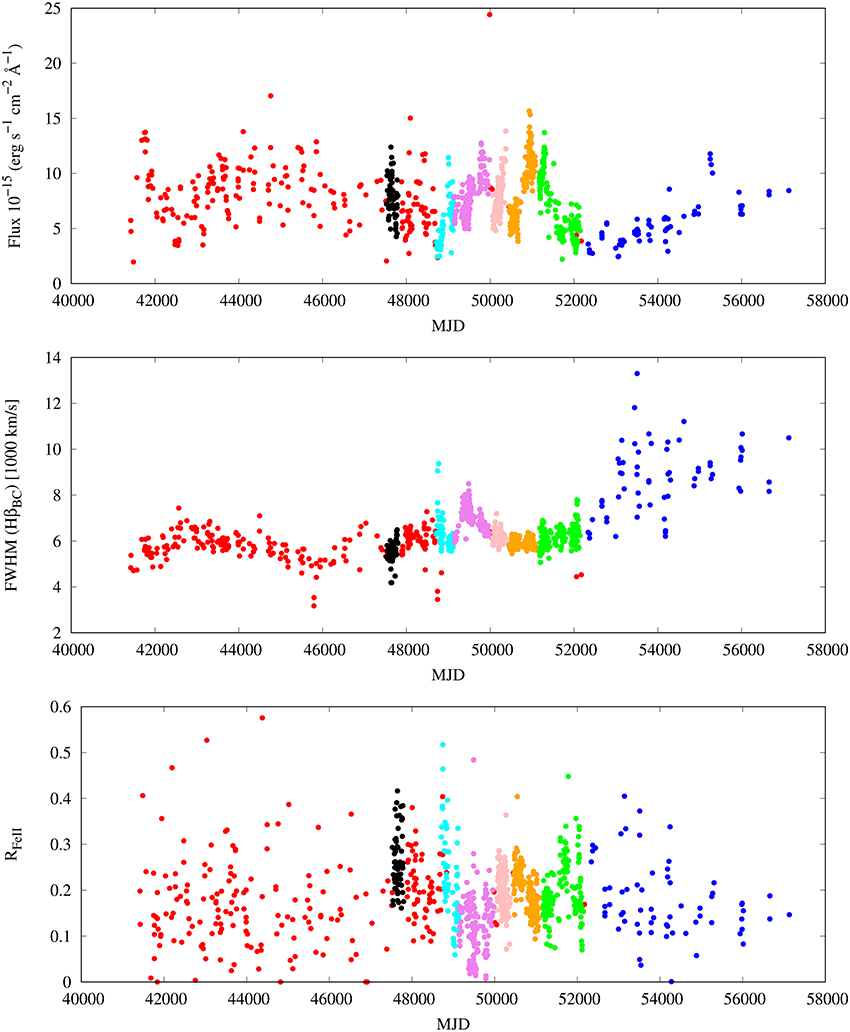
Figure 1. Variability in the NGC 5548 spectra: (top) The light curve of the continuum measured at 5100 Å; (middle) FWHM Hβ variations; (bottom) RFeII change with the time. Colors correspond to different time intervals.
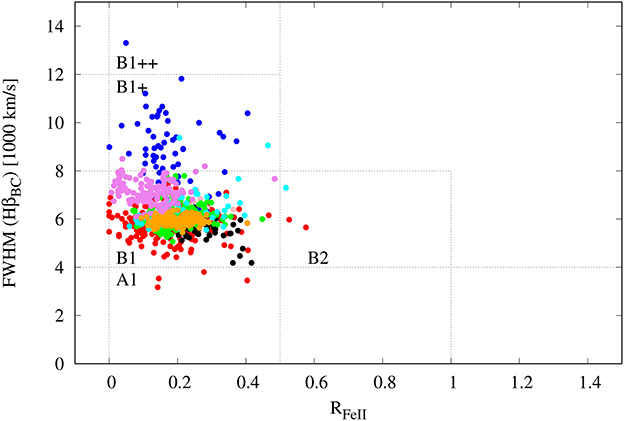
Figure 2. The EV1 diagram of NGC 5548 spectral properties during 43 years of monitoring campaigns. Colors correspond to those in the Figure 1.
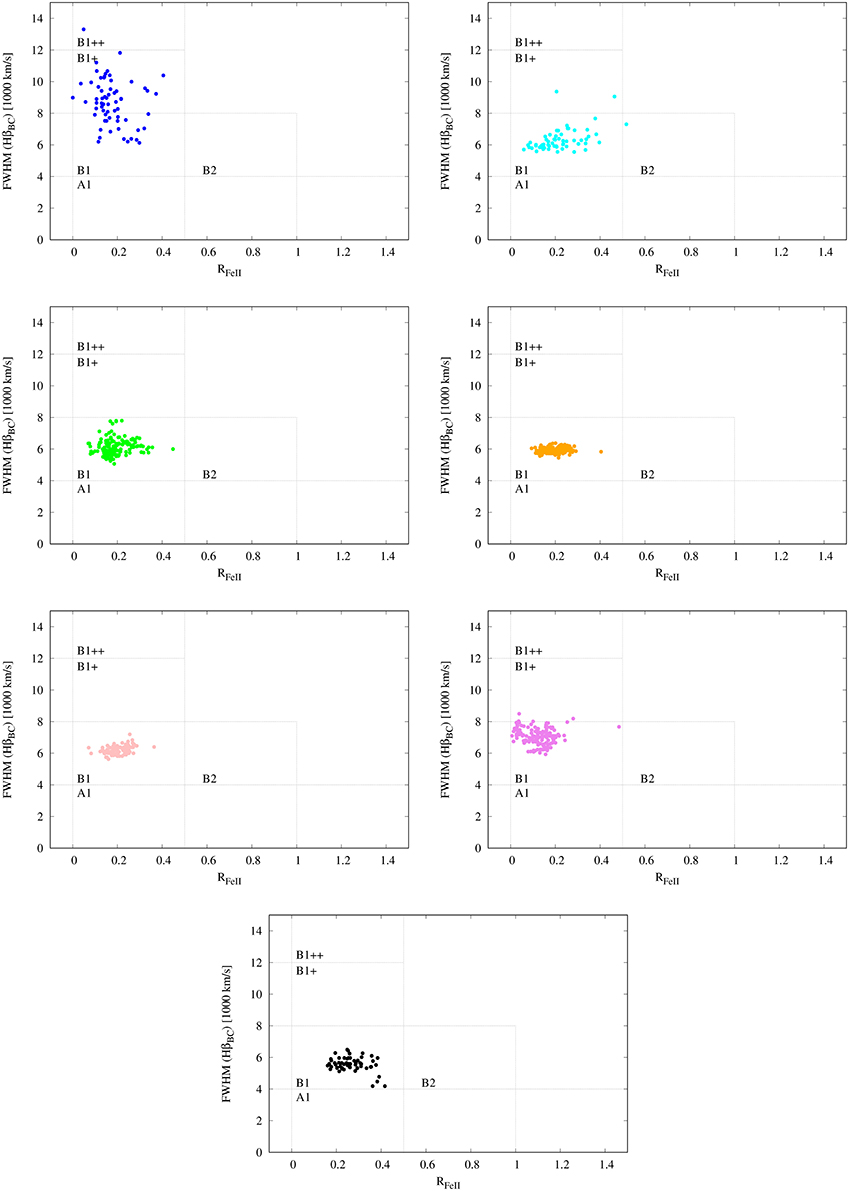
Figure 3. The EV1 diagram of NGC 5548 spectral properties for different time intervals. Colors correspond to those in the Figure 1.
It is expected that both inclination and the black hole mass play a significant role in the physical characterization of the AGN main sequence diagram, but in the case of the inspection of EV1 parameters of a single object through time, we expect inclination and black hole mass to be constant during the whole observational time. Therefore, the main driver of the variability along the EV1 diagram is expected to be associated with variations in accretion rate (since the black hole mass is fixed, accretion rate is proportional to both luminosity [for fixed radiative efficiency] and Eddington ratio). To analyze that, we show variations of L/LEdd against RFeII in Figure 4. We notice that decrease of L/LEdd is followed by an increasing RFeII, mainly in intervals when the flux shows large changes in very short time intervals (represented with high Pearson's correlation coefficient), both in the continuum, as well as in the Hβ line, indicating that changes along the EV1 diagram of the single object could be due sudden and fast changes in accretion rate. We find also that accretion rate and FWHM show modest correlation coefficient in complete monitoring interval, while in short time variations it may be quite high (see Figure 5). The L/LEdd is obtained from the luminosity and the black hole mass, but since the mass is assumed constant, then the FWHM should not affect the L/LEdd. We calculated L/Ledd using continuum flux measurements at 5100 assuming the bolometric correction factor 10 to the specific luminosity measured at 5100 Å (see Sulentic et al., 2006). The mass of the black hole is assumed to be 5.7 × 107 M⊙, as in the paper (Bon et al., 2016). Therefore, the study of a single object has the advantage that FWHM and L/LEdd measurements are independent. On the converse, in the study of quasar samples, the FWHM is used to compute MBH, and hence L/LEdd and FWHM are not independent parameter.
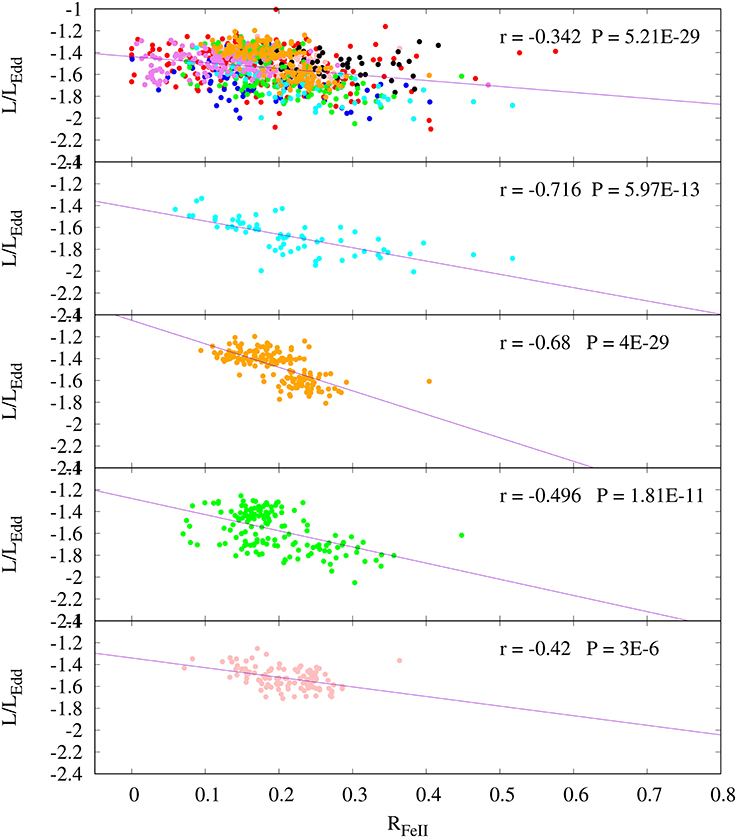
Figure 4. The negative trend: L/LEdd decrease with the increase of RFeII with the time. The strongest anti-correlation was found for well defined time intervals presented on the middle and bottom panel. Colors correspond to those in Figure 1, 2.
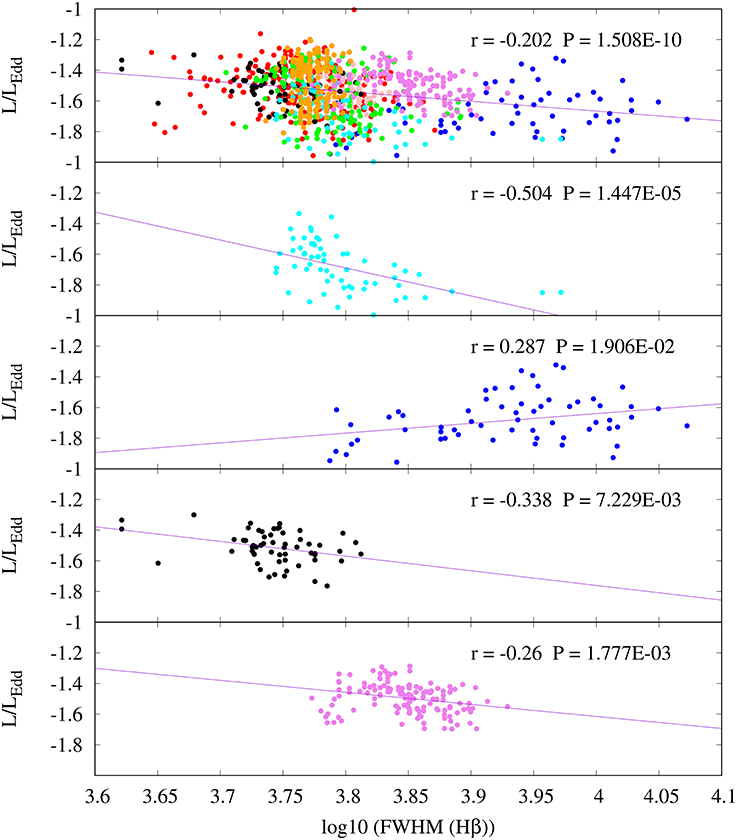
Figure 5. L/LEdd vs. log10(FWHM) trends for long term (top) and short term variations (middle and bottom). Correlation coefficients are marked on each plot. Colors correspond to those presented in Figure 1, 2.
Since NGC 5548 has not undergone major structural change over ~ 40 years of observations, if the physical parameter that drive EV 1 is Eddington ratio, then it appears that the source never crossed the boundary for structural changes, indicatively placed at L/LEdd ~ 0.2.
A decrease in FWHM with increasing L/LEdd would be consistent with the expectations of an increasing effect of radiation forces with increasing luminosity. The absence of a strong relation is only in apparent contradiction with the expectation of the model by Netzer and Marziani (2010). We found a very weak anti-correlation between FWHM and L/LEdd, with a slope of ≈ −0.07 1 (with Pearson correlation coefficient of −0.18, and a significance of 7 × 10−9). We also found a significant but weak anticorrelation between FWHM of Hβ line and continuum, with a modest slope (see Figure 6). For the typical L/LEdd of NGC 5548, radiation forces have a relatively little effect on the dynamics of the line emitting clouds. A FWHM change should be limited to ≲ 10% (Table 1 of Netzer and Marziani, 2010), as indeed suggested by the trend found from the actual data (with a slope −0.07, a three-fold increase in continuum implies a narrowing by ≈ 8%). There is therefore no contradiction between a weak and shallow correlation and a minor role of radiation forces.
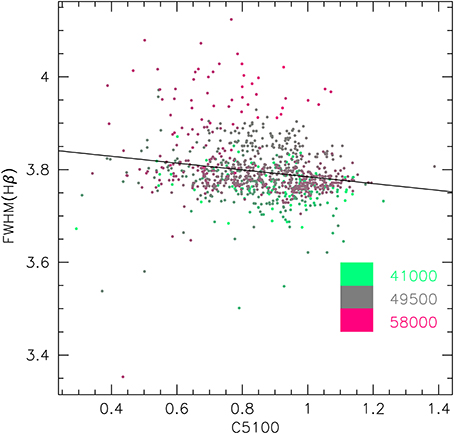
Figure 6. Anti-correlation between FWHM of Hβ and continuum specific flux at 5100 Å. The line shows an unweighted least squares fit. Colors of data points are coded from green to magenta according to Julian date, from 2441000 to 2458000.
In the studies of quasar samples it is showen that FWHM of Hβ increases, because of the increase of the black hole mass For an individual object the story is different. The most reasonable assumption is that the virial product is constant r × FWHM2 = constant2. If r scales with luminosity as r ∝ La, then FWHM ∝ L−a/2, which is not far from the trend we detect for the complete monitoring interval (see Figure 6). But for short time variability epochs trends are different for each segment that we defined (see Figure 7 and marked trends on each panel). It is interesting that in the time interval marked with blue, we see the positive trend of luminosity against FWHM of Hβ broad emission line (see Figure 7). This time interval corresponds to long term variation of flux slowly increasing for 12 year, starting from deep minimum in the low state and ending up toward the high state. In contrary to it, short term variations (for e.g., cyan and pink) shows negative trends (see panels in Figure 7).
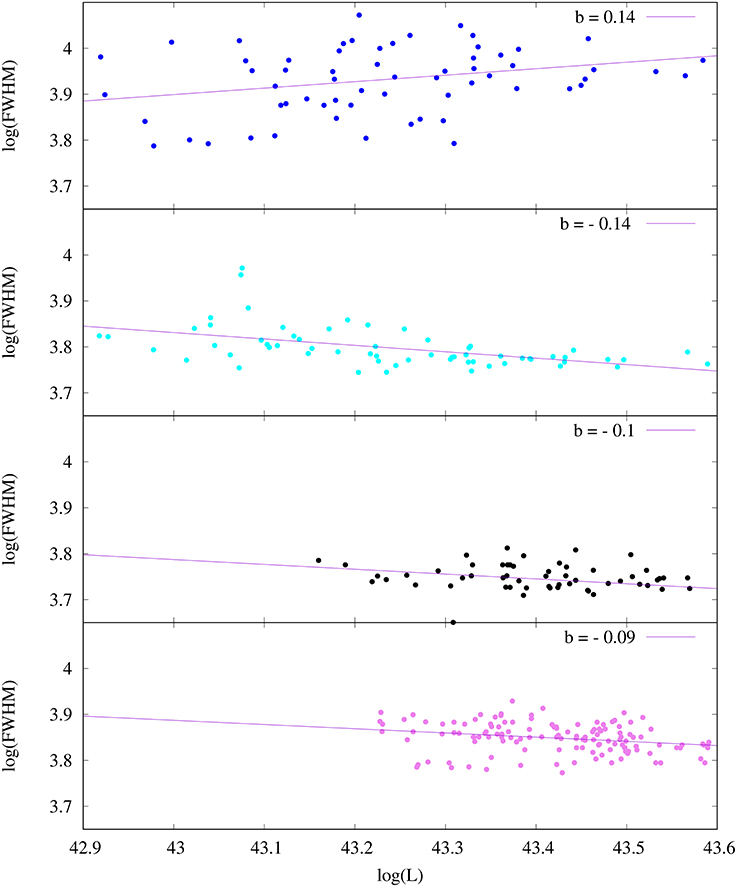
Figure 7. Trends of luminosity against FWHM of Hβ for long term (blue represents last 12 years of observations) and short term variations (cyan, black, and pink are order of months). Lines shows an unweighted least squares fit. Colors of data points correspond to those presented in the Figure 1. Values of slope trends are marked on each plot.
In addition, right the recent work of Pei et al. (2017) finds, for two different time lapses T1 and T2, mean continuum fluxes at 5100 Å and line Hβ line widths: T1) mean flux = 11.31 ± 0.08, FWHM (km s−1) = 9612 ± 427 and T2) mean flux = 12.51 ± 0.04, FWHM (km s−1) = 9380 ± 158. The trend between the two time ranges, implies a decrease in the FWHM when the source is brighter. Without considering the measurement dispersion in FWHM the slope is right −0.25, as predicted by the elementary consideration above in case of r ∝ L1/2, and therefore FWHM ∝ L−1/4, since r ∝ FWHM−2.
The resulting slope for the full sample (−0.07) is the result of mixing together different epochs in which the response of the BLR is different as per the short-term “breathing effect” first described by Netzer and Maoz (1990) and discussed in full by Korista and Goad (2004).
We believe that the weak anticorrelation we found deserves further analysis separately considering different states of continuum level/behavior, as well as changes in the structure factor fS that, evidently, cannot be assumed as a constant, but we do not think that the shallow trend is inconsistent with existing data of reverberation mapping campaigns.
Flattened, disk like, structure combined with surrounding isotropic region is usually good approximation of the BLR structure, so the line profile of population B sources can be approximated as the sum of a accretion disk profile component describing wings of the broad emission line, + an isotropic component describing the intermediate broad core of the broad line which is blending the double peaked shape of an accretion disk profile, producing the single peaked line profile with very broadened wings, typically seen in the AGN broad emission line profiles (see, e.g., Popović et al., 2004; Bon, 2008; Bon et al., 2009a,b). The optically thick core responding more strongly than continuum changes that the accretion disk component could also produce an anti-correlation between FWHM and continuum intensity. We plan to test this possibility in a forthcoming work.
The trend L/LEdd against RFeII is also difficult to explain. In principle, both Marziani et al. (2001) and Shen and Ho (2014) agree that an increase in L/LEdd should lead to higher RFeII. This deduction was however reached from the analysis of a large sample of quasars, and not from the behavior of an individual source. Since RFeII is the ratio of two quantities that both vary, it is important to know how the intensity and the EW of Hβ and FeII vary separately. Hβ shows a highly significant anti-correlation between its equivalent width and the continuum, with a lsq best-fit slope of ≈ −0.26 which is highly significant for 980 data points. This anti-correlation (the “Baldwin effect”) is significantly steeper for FeII: the slope is ≈ −0.60. These dependencies reflect a different response to continuum changes for Hβ and FeII: while the flux of Hβ is correlated with continuum flux with a slope ≈ 0.80, implying a strong response, the response of FeII is much weaker, with I(FeII) ∝ 0.40 I(cont). Therefore, the EW of the FeII increases more than the EW of Hβ when continuum is low, in turn increasing RFeII. These considerations suggest that a parallel between the behavior of large samples and the one associated with the variability of an individual object cannot be drawn, and that NGC 5548 does not challenge the notion of a positive relation between RFeII and L/LEdd found in large quasar sample.
The preliminary results summarized in this paper suggest that NGC 5548—a highly variable object that over several decades has seen large-amplitude continuum fluctuations and flaring behavior—remains a source of Pop. B, its variability notwithstanding. The location of NGC 5548 in the optical plane of E1 remains constrained within spectral type B1. The range in Eddington ratio, even when the source is in a bright state, remains consistent with the value of the lowly—accreting Pop. B, implying that the source has not undergone major structural changes during the 40+ years it was monitored.
EB is responsible for developing the idea, NB for doing the fitting, NB, EB and PM for analysing the results and writing the text of the manuscript and discussing results.
This research is part of projects 176003 “Gravitation and the large scale structure of the Universe” and 176001 “Astrophysical spectroscopy of extragalactic objects” supported by the Ministry of Education and Science of the Republic of Serbia.
The authors declare that the research was conducted in the absence of any commercial or financial relationships that could be construed as a potential conflict of interest.
The reviewer, MD, declared a shared affiliation, though no other collaboration, with the authors, NB and EB, to the handling Editor.
We would like to thank to Jack Sulentic and Martin Gaskell for helpful comments.
1. ^logFWHM ~ (−0.073 ± 0.0125)(logL) + (3.858 ± 0.0108)
2. ^Also f, the form factor should not be constant rigorously speaking, but let us assume at the moment it is.
Bon, E. (2008). The disk emission in single peaked lines for 12 AGNs. Serb. Astron. J. 177, 9–13. doi: 10.2298/SAJ0877009B
Bon, E., Gavrilović, N., La Mura, G., and Popović, L. Č. (2009a). Complex broad emission line profiles of AGN - Geometry of the broad line region. New Astron. Rev. 53, 121–127. doi: 10.1016/j.newar.2009.09.007
Bon, E., Popović, L. Č., Gavrilović, N., La Mura, G., and Mediavilla, E. (2009b). Contribution of a disc component to single-peaked broad lines of active galactic nuclei. Mon. Not. R. Astron. Soc. 400, 924–936. doi: 10.1111/j.1365-2966.2009.15511.x
Bon, E., Zucker, S., Netzer, H., Marziani, P., Bon, N., Jovanović, P., et al. (2016). Evidence for Periodicity in 43 year-long Monitoring of NGC 5548. Astrophys. J. Suppl. 225:29. doi: 10.3847/0067-0049/225/2/29
Bon, N., Popović, L. Č., and Bon, E. (2014). Efficiency tests for estimating the gas and stellar population parameters in Type 2 objects. Adv. Space Res. 54, 1389–1400. doi: 10.1016/j.asr.2014.06.040
Boroson, T. A., and Green, R. F. (1992). The emission-line properties of low-redshift quasi-stellar objects. Astrophys. J. Suppl. 80, 109–135. doi: 10.1086/191661
Fraix-Burnet, D., Marziani, P., D'Onofrio, M., and Dultzin, D. (2017). The phylogeny of quasars and the ontogeny of their central black holes. Front. Astron. Space Sci. 4:1. doi: 10.3389/fspas.2017.00001
Koleva, M., Prugniel, P., Bouchard, A., and Wu, Y. (2009). ULySS: a full spectrum fitting package. Astron. Astrophys. 501, 1269–1279. doi: 10.1051/0004-6361/200811467
Korista, K. T., and Goad, M. R. (2004). What the optical recombination lines can tell us about the broad-line regions of active galactic nuclei. Astrophys. J. 606, 749–762. doi: 10.1086/383193
Marziani, P., Sulentic, J. W., Stirpe, G. M., Zamfir, S., and Calvani, M. (2009). VLT/ISAAC spectra of the Hβ region in intermediate-redshift quasars. III. Hβ broad-line profile analysis and inferences about BLR structure. Astron. Astrophys. 495, 83–112. doi: 10.1051/0004-6361:200810764
Marziani, P., Sulentic, J. W., Zwitter, T., Dultzin-Hacyan, D., and Calvani, M. (2001). Searching for the Physical Drivers of the Eigenvector 1 Correlation Space. Astrophys. J. 558, 553–560. doi: 10.1086/322286
Netzer, H., and Maoz, D. (1990). On the emission-line response to continuum variations in the Seyfert galaxy NGC 5548. Astrophys. J. Lett. 365, L5–L7. doi: 10.1086/185875
Netzer, H., and Marziani, P. (2010). The effect of radiation pressure on emission-line profiles and black hole mass determination in active galactic nuclei. Astrophys. J. 724, 318–328. doi: 10.1088/0004-637X/724/1/318
Pei, L., Fausnaugh, M. M., Barth, A. J., Peterson, B. M., Bentz, M. C., De Rosa, G., et al. (2017). Space telescope and optical reverberation mapping project. V. optical spectroscopic campaign and emission-line analysis for NGC 5548. Astrophys. J. 837:131. doi: 10.3847/1538-4357/aa5eb1
Peterson, B. M., Berlind, P., Bertram, R., Bischoff, K., Bochkarev, N. G., Borisov, N., et al. (2002). Steps toward determination of the size and structure of the broad-line region in active galactic nuclei. XVI. A 13 year study of spectral variability in NGC 5548. Astrophys. J. 581, 197–204. doi: 10.1086/344197
Popović, L. Č., Mediavilla, E., Bon, E., and Ilić, D. (2004). Contribution of the disk emission to the broad emission lines in AGNs: two-component model. Astron. Astrophys. 423, 909–918. doi: 10.1051/0004-6361:20034431
Sergeev, S. G., Doroshenko, V. T., Dzyuba, S. A., Peterson, B. M., Pogge, R. W., and Pronik, V. I. (2007). Thirty years of continuum and emission-line variability in NGC 5548. Astrophys. J. 668, 708–720. doi: 10.1086/520697
Shakura, N. I., and Sunyaev, R. A. (1973). Black holes in binary systems. Observational appearance. Astron. Astrophys. 24, 337–355.
Shen, Y., and Ho, L. C. (2014). The diversity of quasars unified by accretion and orientation. Nature 513, 210–213. doi: 10.1038/nature13712
Sniegowska, M., Czerny, B., You, B., Panda, S., Wang, J.-M., Hryniewicz, K., et al. (2017). The properties of active galaxies at the extreme of eigenvector 1. ArXiv e-prints.
Sulentic, J. W., Marziani, P., Zwitter, T., Dultzin-Hacyan, D., and Calvani, M. (2000). The demise of the classical broad-line region in the luminous quasar PG 1416-129. Astrophys. J. Lett. 545, L15–L18. doi: 10.1086/317330
Sulentic, J. W., Repetto, P., Stirpe, G. M., Marziani, P., Dultzin-Hacyan, D., and Calvani, M. (2006). VLT/ISAAC spectra of the Hβ region in intermediate-redshift quasars. II. Black hole mass and Eddington ratio. Astron. Astrophys. 456, 929–939. doi: 10.1051/0004-6361:20054153
Keywords: galaxies:active-galaxies, quasar:supermassive black holes, quasar:emission lines, line:profiles, quasar: individual (NGC 5548)
Citation: Bon N, Bon E and Marziani P (2018) AGN Broad Line Region Variability in the Context of Eigenvector 1: Case of NGC 5548. Front. Astron. Space Sci. 5:3. doi: 10.3389/fspas.2018.00003
Received: 31 October 2017; Accepted: 12 January 2018;
Published: 31 January 2018.
Edited by:
Fabio La Franca, Università degli Studi Roma Tre, ItalyReviewed by:
Milan S. Dimitrijevic, Astronomical Observatory, SerbiaCopyright © 2018 Bon, Bon and Marziani. This is an open-access article distributed under the terms of the Creative Commons Attribution License (CC BY). The use, distribution or reproduction in other forums is permitted, provided the original author(s) and the copyright owner are credited and that the original publication in this journal is cited, in accordance with accepted academic practice. No use, distribution or reproduction is permitted which does not comply with these terms.
*Correspondence: Nataša Bon, bmJvbkBhb2IuYmcuYWMucnM=
Disclaimer: All claims expressed in this article are solely those of the authors and do not necessarily represent those of their affiliated organizations, or those of the publisher, the editors and the reviewers. Any product that may be evaluated in this article or claim that may be made by its manufacturer is not guaranteed or endorsed by the publisher.
Research integrity at Frontiers

Learn more about the work of our research integrity team to safeguard the quality of each article we publish.